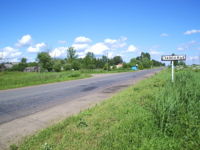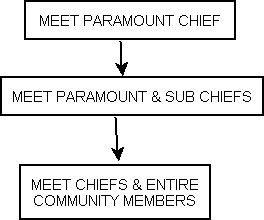Lesson 3: Community Entry
Contents
- 1 INTRODUCTION
- 2 LEARNING OUT COMES/SPECIFIC OBJECTIVES
- 3 LESSON CONTENT
- 4 DEFINITION OF COMMUNITY ENTRY:
- 5 CRITICAL ACTIONS IN COMMUNITY ENTRY
- 6 PROCESS
- 7 ADVANTAGES USING CONTACT PERSONS
- 8 DISADVANTAGES
- 9 TYPES
- 10 CHN TASKS
- 11 CHALLENGES WITH CONTCT PERSONS
- 12 WOMEN AS SPECIAL RESOURCE
- 13 CONDUCT MEETING WITH COMMUNITY LEADERS
- 14 SOURCES OF INFORMATION
- 15 SKILLS AND ATTITUDES REQUIRED OF HEALTH WORKERS IN UNDERTAKING COMMUNITY ENTRY
- 16 ADVANTAGES OF COMMUNITY ENTRY
- 17 Summary
- 18 Assignment
INTRODUCTION
Entering the community is an important task the community health nurse does to acquaint him/herself to his/her area of work.
LEARNING OUT COMES/SPECIFIC OBJECTIVES
By the end of the lesson the student should be able to:
- explain community entry
- describe the preparations made before a community is entered
- identify critical actions in community entry
- list the advantages of community entry
LESSON CONTENT
DEFINITION OF COMMUNITY ENTRY:
- Community entry refers to the process of initiating, nurturing and sustaining a desirable relationship with the purpose of securing and sustaining the community’s interest in al aspect of a programme.
- Community entry refers to the process, principles and techniques of community mobilisation and participation. This involves recognizing the community its leadership and people and adopting the most appropriate process in meeting, interacting and working with them.
- PREPARATIONS MADE BEFORE ENTRY
- form a reconnaissance team which is a team which spy.
- read about the community (read annual report from the DHMT, District Assembly or from our serious *or special report, disease durance report, news papers health journals)
- collect informal information about the community (this is done through interview with individuals, through focus groups discussion, through mapping, contact opinion leaders, through house to house census)
- transect walk and observation.
CRITICAL ACTIONS IN COMMUNITY ENTRY
- Identify the community by gathering information through formal and informal means.
- Reading from available literature
- Talking to knowledgeable people:
- Informal sources such as market places, drinking bars, funerals, festive occasions etc.
- Identify the leadership
It is very important to recognise the position and roles of the community leaders in order that they will help the community health officer to develop ways in seeking their co-operation and support for programme Implementation. In meeting with chiefs and their stool/skin elders, it is important to schedule meeting, times to suit the convenience of the traditional leaders.Follow protocol;
- Meet the paramount chief first and discuss your mission e.g. to know the history of the community and new health programme.
- Meet elders also if possible.
PROCESS
- Knock and enter upon response.
- first greet chief and elders. Introduce yourself to the chief elders and other local leaders.
- inform them of your work with them.
- ask for their permission and advice and state your mission e.g. getting information about the village or introduction of new health programme.
- thank them for their co-operation.
NB The community health officer can get ideas on contact persons/groups in the community whose support would facilitate your work.
- Identify contact persons
Apart from the chiefs and elders, there are various interest groups and personalities in every community who must be identified to serve as contact persons in working with the community.
Various interest groups and personalities in the community who can serve as contact persons are:
- Prominent head of families.
- Heads of schools/teachers.
- Religious leaders/catechists
- District assembly members.
- Unity committee members
- Youth leaders
- Women group leaders
- The water and sanitation committee (
- Disease surveillance volunteers.
- Traditional birth attendants. (TBA’s)
- Other health workers.
ADVANTAGES USING CONTACT PERSONS
- Good organisers people respect their authority.
- Their presence helps people see the issues as important.
- Trust by their people.
- They are credible
DISADVANTAGES
- Sometimes not respected-so people may not come to the meeting.
- Presence at meetings may discourage people from talking.
TYPES
- Assembly members
- Unity commttee members
- Area council members
- heads of schools
- teachers, religious leaders
- Popularly elected/selected members,they represent the people.
CHN TASKS
- Set up meetings.
- Know community priorities.
- Links with opinion leaders.
- Helpful in chieftaincy disputes.
CHALLENGES WITH CONTCT PERSONS
- Some may have lost credibility.
- Some may embezzle funds.
- Some dominate meetings.
- Some may have conflict with chiefs.
- Some may be too bossy to help
WOMEN AS SPECIAL RESOURCE
As care takers in the family, women are key players in the promotion of primary Health Care in communities.Women are more familiar with child health problems
CONDUCT MEETING WITH COMMUNITY LEADERS
In traditional Ghana, leadership lies in the hands of a hierarchy of persons ranging from paramount chiefs through town/village chiefs, clan/lineage heads to family heads. At each of these levels of leadership, communities have their own schedules and plans of carrying out development activities. There is therefore the need to recognize the position and roles of the community leaders in order that the most suitable ways could be developed in seeking their co-operation and support for program implementation.
- In organising meetings with chiefs and their stool/skin elders. It is important to schedule meting times to suit the convenience of the traditional leaders. The following levels of meetings with chiefs should be followed during the advocacy and consultation for applying the CHPS process:
- Meet the paramount chief first and discuss the new health program with him. Allow him time to discuss your proposals with his sub-chiefs and elders.
- Meet the chiefs of the selected communities and discuss the program with them.
- Meet the chiefs and their elders and the community at large and discuss the program at the sub-district Start-Up Forum and subsequent community meetings.
- Outline your mission to them
- Brief them on what you are there to do
- Ask them o freely support you.
- Identify the leadership
- Identify contact persons
- Conduct meeting community leaders
- Outline your mission to them
- Brief leaders of the purpose of your visit;
- Seek approval and support for your programme.
- Study and be conversant with the custom and tradition of the people(community study)
SOURCES OF INFORMATION
- Reading from available literature;
- Talking to knowledgeable people;
- Informal sources such as market places, drinking bar, funerals, festive occasions etc
- OTHER SOURSES OF INFORMATION:
Apart from using community leaders and contact persons through the application of (PLA) Participatory Learning and Action techniques to collect data in community entry, secondary information could be collected from documentary sources. These include: Annual reports of DHMT, District Assembly, Dept. of Community Development, Dept of Environmental Health; Special project reports such as Nutrition, Family Planning etc
SKILLS AND ATTITUDES REQUIRED OF HEALTH WORKERS IN UNDERTAKING COMMUNITY ENTRY
- SKILLS
- Maintain good eye contact.
- Listen to both sides of and issue
- Paraphrase
- Show interest
- Be empathetic
- Encourage others to listen.
- ATTITUDE
- Patience
- Tolerance
- Respect for other people
- Good listening attitude
- Humility
- NB
- Ensure that community members understand the message and are encouraged to ask question when necessary.
- Probe to find out reasons why the community members may not be well with other leaders through asking relevant questions, encouraging answers as well as holding discussions with them.
- Ensure that message is clear and avoid unnecessary semantics and jargons.
- Encourage effective dialogue through the us of effective 2- way communication skills.
- Create humour and interacts in a way that helps to build the environment for effective interpersonal relationships.
ADVANTAGES OF COMMUNITY ENTRY
- objectives will be achieve
- gain support
- it ensures the establishment of good working relationship
- it helps one to plan his / her work
- it helps to observe protocols.
TESTS AND QUIZZES
- Explain skills and attitudes should the CHO employ during community entry.
- Describe the strategies the CHO should employ to win the support of chief, elders and community members.
REFERENCES:
- MOH/GHS (2002 ) Community Mobilisation and Participation Training Manual; Community-Based Health Planning and Services.
- JHPIEGO(2003) CHPS Learning Package For Community Schools Trainer’s/Preceptors’ Manual ; 1. Community Health Nursing.
Jaquansah 18:25, 1 March 2007 (CET)

